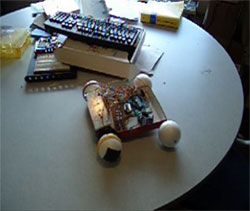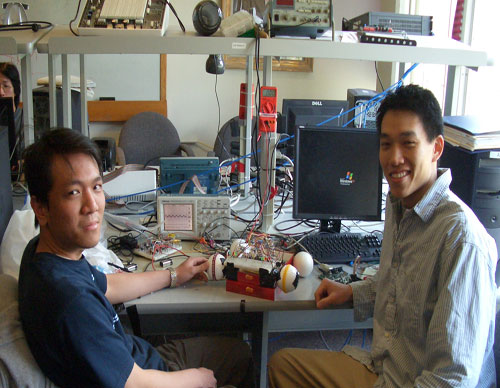| # ( Results )
|
| After an arduous month we met
our goal: to build a robot that can detect and follow light. The finished
product did not stray far from our original vision, which is very satisfying.
The robot is very easy to interface, since anyone with a flashlight or lamp can
use it. Although we had to remove extra features, we were able to include
calibration and variable speed. The robot is also very responsive to the light
around it. In fact, it was so responsive we had to take measures to decrease
responsiveness. In the beginning we were unsure how well the sensors would work
during the day, but the LDR's proved to be very effective. A user can shine a
flashlight about two feet away in the presence of daylight and LightRover will
still respond correctly. Ideally, the user should be about a foot away.
Finally, the wheels perform much better on a smooth surface, such as a tabletop
or in the halls of Philips than on carpet. See below for a video of LightRover
in action. |
 |
| Video
(AVI): LightRover in action |
| # ( Conclusion )
|
| We worked
hard and are both proud of our final product. Although it was disappointing
when we had to remove our extra features, we were happy (and relieved) to see
the robot function as intended. Our completed project garnered a good amount of
attention and the other students seemed thoroughly impressed. Perhaps the most
impressive was how well the robot executed turns. This project did prove to be
a very educational experience, as we drew on our knowledge from a wide range of
subjects. |
 |
| Creators
and creation: Thientu Ho (left, creator), David Shu (right, creator),
LightRover (center, creation) |
| # ( Lessons Learned
) |
| Consider everything. We did
not expect to have so much trouble with the wheels, especially because of the
simple design. We kept our original design very realistic, taking our limited
knowledge of mechanical details into consideration, and yet we spent a lot of
time dealing with wheels and materials. Finally, this project further proved
that it is never safe to assume anything, especially when it comes to your
circuit. Even when you verified that it worked ten minutes earlier.
Mischevious circuit gnomes have a way of disconnecting wires while your head is
turned away. |
| # ( Safety )
|
| The robot itself is not
harmful because it will not move at a very fast speed. However, the CDS-T08
photocell sensors use
Cadmium
Sulfide (CDS) which is reported to be flammable and a known carcinogen. It
is important to keep the sensors away from open flames and food. It is also
extremely important not to touch the sensors, but if skin contact occurs to wash
hands throughly with soap and water. CDS is also known to have effects on the
kidney, lung, and bone. Contact a physician if necessary. |
| # ( Ethical
Considerations )
|
- to accept responsibility in
making engineering decisions consistent with the safety, health and welfare of
the public, and to disclose promptly factors that might endanger the public or
the environment;
- We spent some time thinking
if there were any possible dangers possible. We warned people about the
potential hazards of the CDS sensor, and that warning is also in writing on this
web page.
- to seek, accept, and offer
honest criticism of technical work, to acknowledge and correct errors, and to
credit properly the contributions of others;
- We often sought out the help
of the course staff and appreciated their insight. We also appreciated the
comments from bystanders watching us test LightRover in the lab.
- to avoid injuring others,
their property, reputation, or employment by false or malicious action;
- LightRover does not move fast
enough to damage anything, and we were very respectful of other people's
property and projects.
- to improve the understanding
of technology, its appropriate application, and potential consequences;
- The purpose of this project
was to learn about sensors, motors, and design. It was very hands on and we
learned more than just the technical details.
- to assist colleagues and
co-workers in their professional development and to support them in following
this code of ethics.
- We tried to be as
accomodating as possible to the other groups. For example, another group
happened to use the same bipolar stepper motor as the ones we used and asked us
how we were able to get it to work. We answered their questions to the best of
our ability.
|
| # ( Other Considerations
)
|
| As far as we know, the
LightRover project does not infringe on any patents. We wrote all our own code
and it is now public domain. We do not intend on profiting from this project,
it was for educational purposes only. |
| # ( Thanks )
|
| Thanks to the entire 476
staff for all their help and for keeping the lab open. |
| |

